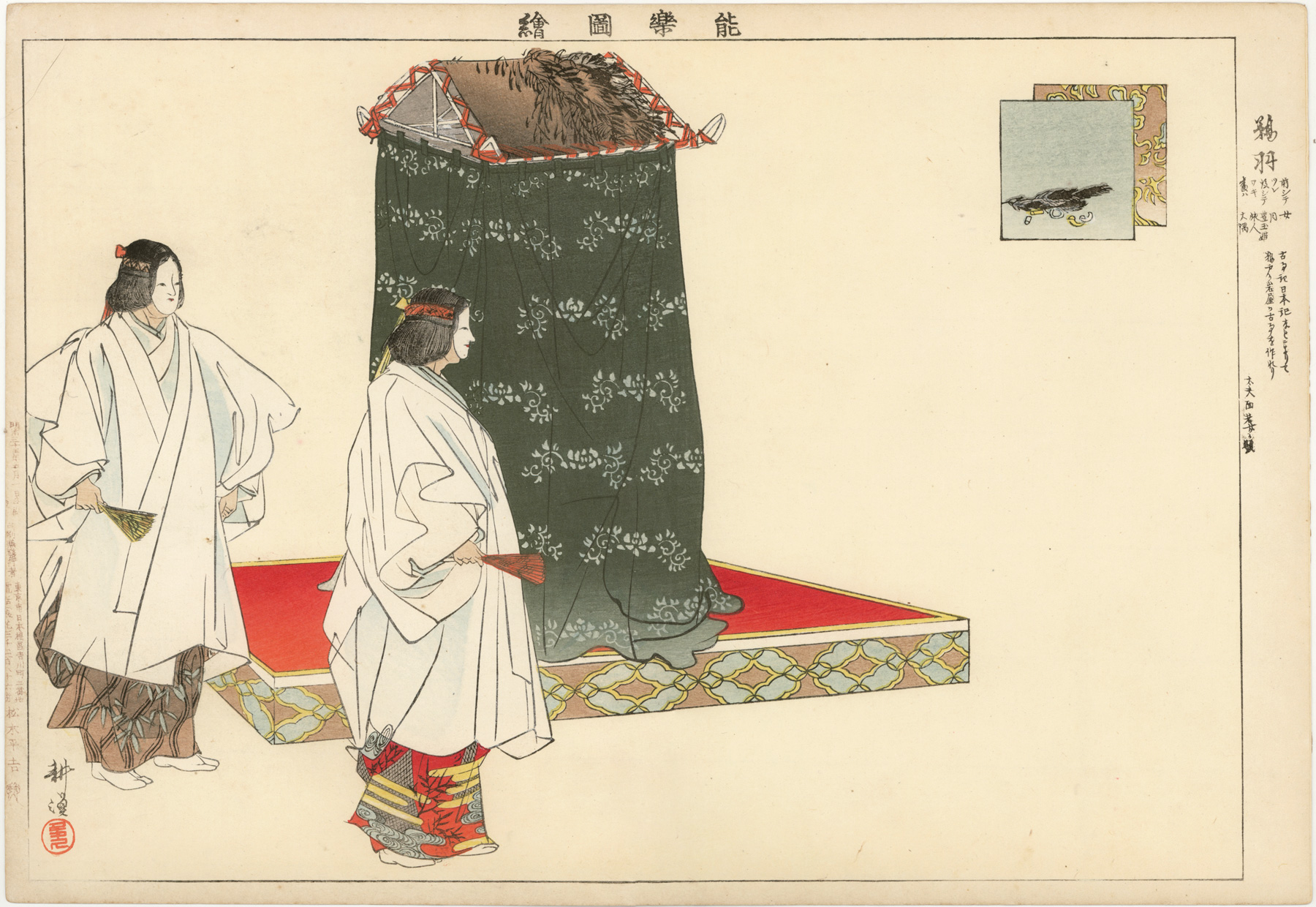About This Print
Right Margin Description of Scene
click on image to enlarge
The Play - Unoha by Zeami
Source: Developing Zeami: The Noh Actor's Attunement in Practice, Shelley Fenno Qunin, University of Hawaii Press, 2005, p. 405.The play is set on the shoreline in Hyūga Province and retells the myth of the birth there of the Shintō deity Unoha fuki awasezu no mikoto (deity of the hut partially thatched with cormorant feathers.) His father was the Shintō deity Hiko hohodemi no mikoto, and his mother the dragon princess Toyotamahime (princess of abundant jewels) from the dragon palace under the sea. Through this untion, Hiko hohodemi no mikoto came into possession of the precious jewels that controlled the waxing and waning of the tides. The couple came to earth when she became pregnant, and Hiko hohodem no mikoto managed to thatch only part of the parturition hut before the birth occurred, which is how the child received his name.
Toyotamahime is the shite of the second act of Unoha. The play is set on the birthday of the child. The shite of the first act appears as a young woman who makes her living from the sea; she appears with a young female cohort (tsure). They encounter the waki, a retainer of the emperor, and his attendant (waktsure), who are there to pay their respects at this famous spot. The women retell the myth of the birth and go through the motions of thatching the hut. In the second act. Toyotamahime reappears to reveal her identity and to dance. The play ends with the intertwining of the jewel imagery of the Shintō myth and the Buddhist parable. Toyotamahime says to the waki, "The jewels of ebb and flow (raises fan and circles stage) are wondrous treasures and yet, my heart desires the true jewel of enlightenment."
Print Details
| IHL Catalog | #1924 |
| Title | Unoha 鵜羽 (The Cormorant Plumes) |
| Series | Nōgakuzue 能樂圖繪 (Illustrations of Noh) |
| Artist | Tsukioka Kōgyo (1869-1927) |
| Signature |  |
| Seal | Red letter seal in a round shape: 年久 [Toshihisa] as shown above [ref. seal #11, p. 170 in The Beauty of Silence] |
| Date |  Printed on May 1, 1902 / Issued on ? 明治三十五年五月一日印刷 / |
| Edition | unknown |
| Publisher | Matsuki Heikichi (Daikokuya Heikichi 大黒屋平) [Marks: pub. ref. 029] Address 日本橋区吉川町二番地 松木平吉 (in left margin) followed by Daikokuya seal. |
| Carver | |
| Impression | good |
| Colors | excellent |
| Condition | good - minor soiling; album backing paper, left margin partially trimmed |
| Genre | ukiyo-e; 能楽図絵 Nōgaku zue [Noh play picture] |
| Miscellaneous | |
| Format | ōban yoko-e |
| H x W Paper | 9 1/2 x 13 7/8 in. (24.1 x 35.2 cm) |
| H x W Image | 8 13/16 x 12 7/8 in. (22.4 x 32.7 cm) area within printed black border |
| Collections This Print | Art Institute Chicago 1939.2258.206 (1898?); University of Pittsburgh 20091209-kogyo-0407 (May 5, 1902); Japan Arts Council BK014-2521 (May 5, 1902) |
| Reference Literature |
9/24/18



